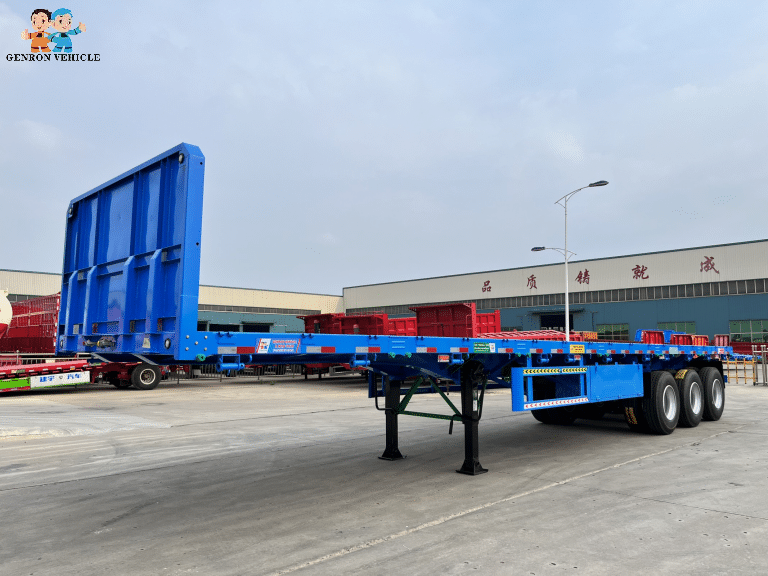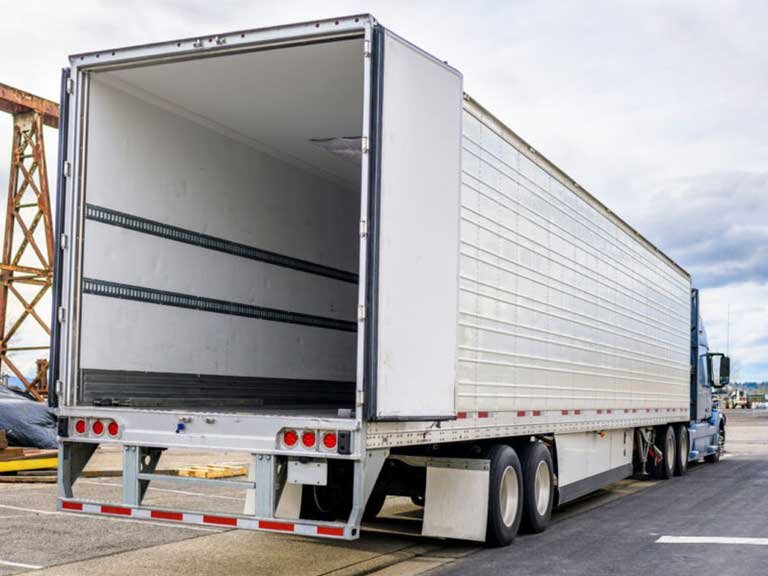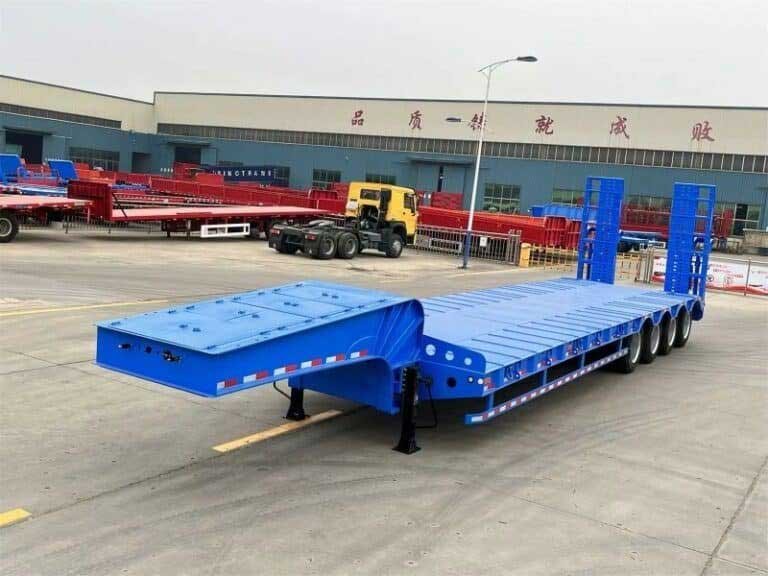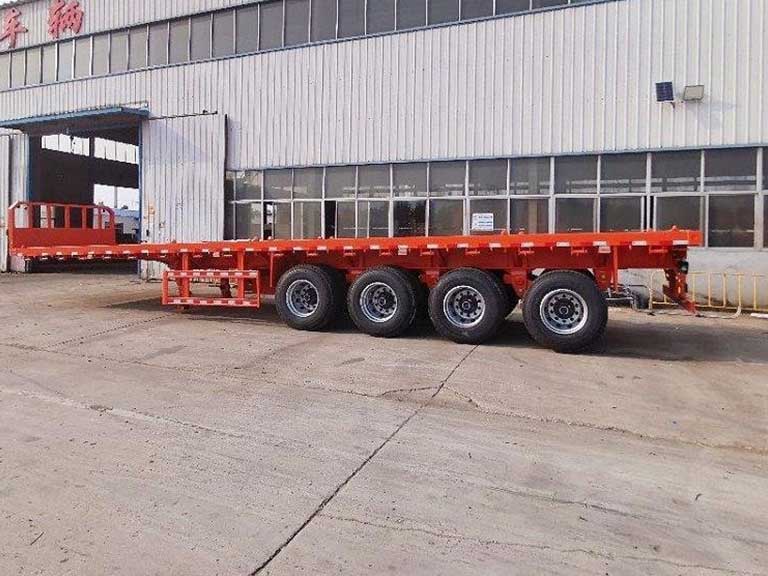In the trucking world, picking the right trailer size is key. It affects how well you work and how successful you are. With so many options, knowing about trailer sizes is crucial for handling loads well and following the law. At Genron International Trade, we help you understand this complex world.
Choosing the right trailer means knowing about truck and trailer sizes. You need to know about truck cab lengths and semi trucks with or without trailers. There are many trailer types, like dry vans and flatbeds, each good for different jobs. Knowing the standard and maximum sizes helps you pick the right one.
This guide aims to share our knowledge with you. We’ll help you compare trailer sizes and think about load weight and towing capacity. Join us as we explore how to pick the best trailer size for you.
Table of Contents
Understanding Truck and Trailer Dimensions
At Genron International Trade, we know how important truck and trailer sizes are. They ensure safe transport and help save costs. The total length of a truck and trailer can vary a lot.
Trailer lengths range from 48 to 53 feet, covering types like dry vans and reefers. Knowing these sizes helps follow the law and avoid overloading. Different trailers, like extendable RGNs, have special features that affect their size and what they can carry.
Overview of Truck Cab Lengths
Knowing truck cab lengths is key for following rules and planning logistics. A semi truck’s cab can be 20 to 30 feet long, depending on the model. This part is important for figuring out the total length of a semi truck with a trailer.
Different places have their own rules for truck lengths. At Genron International Trade, we make sure our designs fit these rules. This ensures our semi trucks work well with different trailers, meeting various transport needs.
Semi Trucks: With and Without Trailers
Semi trucks are different sizes depending on if they have a trailer or not. Without a trailer, they are 15 to 25 feet long. With a trailer, they can be 68 to 80 feet long, with the trailer usually being 53 feet.
This trailer size is common in North America, affecting the total length of the truck. Maximum lengths for trucks and trailers are set for safety and to follow the law. At Genron International Trade, we make sure our semi-trailers meet these standards. This helps with safe transport and following rules in different places.
Begin with a bespoke semi-trailer designed for your exact needs. Whether it’s heavy-duty hauling or specialized cargo, we’ve got the perfect solution to keep you moving forward.
Exploring Different Types of Trailers
At Genron International Trade, we make many types of semi-trailers for different needs. We focus on models like tankers, lowbed trailers, and flatbeds. We know picking the right trailer is important for your cargo.
Whether you need trailers for big loads or to keep goods at the right temperature, we’re here to help. Our trailers are mainly for markets in Africa and Southeast Asia. We offer reliable, customizable options for various transport needs.
Dry Vans
Dry van trailers are very popular because they are versatile. At Genron, our dry vans are 53 feet long, 8.5 feet wide, and 13.5 feet tall. They have lots of space for non-perishable goods.
Their fully enclosed design keeps your cargo safe from wind, rain, and sun. They can carry up to 45,000 lbs, balancing space and protection well. Dry vans are great for shipping both small and large loads. They can hold palletized goods well. Their air ride feature makes loading and unloading easier.
Reefers
Reefers, or refrigerated trailers, are key for moving temperature-sensitive goods. Genron’s reefers are 53 feet long, 8.5 feet wide, and 13.5 feet tall. They have cooling systems to keep goods at the right temperature.
Our reefers can carry up to 42,500 lbs, fitting up to 24 pallets. They can also be used like dry vans without refrigeration. This makes them very flexible for different cargo needs.
Dry vans and Reefer each have different advantages and disadvantages. Therefore, you should choose the right van for your needs.
Flatbeds
Flatbed trailers are known for their versatility. They are 48 to 53 feet long and 8.5 feet wide. Without walls or roofs, they can carry odd-shaped cargo easily.
Our flatbeds can hold cargo up to 8.5 feet tall. They are great for heavy and unique items. They can carry up to 48,000 lbs, perfect for construction equipment or lumber.
For protection, you can use 4, 6, or 8 tarps. This ensures your goods stay safe and dry. Their design and capacity make them a popular choice.

Lowboys
Lowbed trailers can load so much weight that they are commonly used to haul tall items and heavy equipment. They have lower deck heights for more clearance. Genron’s lowboys range from 40 to 53 feet long and can be 10 feet wide.
They are ideal for heavy machinery and oversized cargo. Their design allows for easy transport of large, heavy items. They are essential for construction and industries with big equipment.
Intermodal Trailers
Intermodal trailers work well with different transport modes like rail, truck, and ship. Genron’s intermodal trailers are 53 feet long, 102 inches wide, and 109 inches tall. They can carry 42,500 to 43,000 pounds.
They meet strict railway and road rules, making them great for various transport needs. In addition, they are perfect for businesses that ship palletized goods efficiently. Their design helps in using the benefits of multi-modal shipping.
RGN Trailers
Removable Gooseneck (RGN) trailers are made for moving big equipment and machinery. Genron’s RGN trailers can grow up to 80 feet long. This gives a lot of flexibility for hauling.
The detachable gooseneck turns the trailer bed into a ramp. This makes it easier to load heavy machinery like bulldozers and forklifts.
A standard RGN trailer can carry up to 44,000 pounds legally. This follows transportation rules while handling oversized loads. Despite the costs and complexities of permits, RGNs are key for moving big, diverse cargo. Their design is perfect for heavy equipment transport.
Standard and Maximum Trailer Dimensions
Genron International Trade makes semi-trailers for different needs. Knowing trailer sizes is key for logistics and transport. In North America, semi-trailers are usually 48 to 53 feet long.
They are about 8.5 feet wide, including flatbeds and dry vans. This makes logistics easier and the supply chain smoother. Our trailers meet these standards for seamless operations.
Standard trailers, like flatbeds, are about 5 feet tall. These sizes help keep roads safe and operations efficient. Some places allow bigger trailers for oversized cargo. In Europe, trailer sizes are slightly different.
The maximum legal width is 2.55 meters, with refrigerated trailers allowed an extra width. We offer customizable options for various trailer types to meet each client’s needs.

Legal Regulations Affecting Trailer Sizes
Understanding trailer size laws is complex but crucial at Genron International Trade. In the U.S., federal law limits the length of tractor-trailer combinations to 75 feet. But, states have their own rules for safety on the roads.
Our trailers are made to meet these legal standards, focusing on stability and safety. In the European Union, trailer laws are different. Trailers can be 12 meters long, with a maximum height of 4 meters.
Width is usually 2.55 meters, but refrigerated trailers can be up to 2.60 meters wide. Knowing these rules helps our trailers fit specific needs wherever they are used.
These laws affect length, width, and height, including special rules for refrigerated trailers. We ensure our trailers comply with these laws, giving our customers confidence. By tailoring our products to regional regulations, we provide safe and efficient transport solutions.
Comparing Trailer Sizes for Various Hauling Needs
At Genron International Trade, choosing the right trailer size is key for your hauling needs. Trailers vary in size to fit different cargo and towing needs. For example, car hauler trailers are 8 or 8.5 feet wide.
They can carry various vehicles, including sedans, SUVs, and trucks. Smaller trucks like the Toyota Tacoma fit in 8.5×16’ or 8.5×18’ car hauler trailers. Larger trucks, like the Ford F-150, need 8.5×18’ or 8.5×20’ trailers.
Load Weight Considerations
The weight your truck can carry is key for safety and efficiency. In the semi-truck world, following legal weight limits is important. Semi-truck and trailer combos can be 68 to 80 feet long.
The semi-truck itself is 20 to 25 feet long. The trailer adds an extra 48 to 53 feet. A semi-truck can carry up to 80,000 pounds, including cargo and itself.
Trailer weights vary too. Flatbed and Single-Drop Deck trailers can carry up to 48,000 pounds. Double-Drop Deck trailers, or Lowboys, can carry 45,000 pounds. Detachable Deck trailers have a lower capacity at 44,000 pounds.
Vehicle Towing Capacity
Knowing your vehicle’s towing capacity is crucial. It ensures safe and efficient transport. You can find this in your vehicle’s manual.
When picking a trailer, check if your vehicle can handle the combined weight. Going over your vehicle’s towing capacity can be risky. It’s important to match your vehicle’s towing ability with the trailer’s design for a safe trip.

Storage Requirements
Storage capacity and features of a trailer are key when moving cargo. Enclosed trailers protect goods from weather and offer customizable features. They’re great for various cargo types.
Standard dry van semi trailers are versatile for loading and unloading dry goods. Reefer trailers keep cargo at the right temperature, essential for perishables. Conestoga trailers combine open loading with weatherproofing benefits.
Flatbed trailers offer flexible solutions for oversized or uniquely shaped goods. They have open beds.
Tips for Selecting the Right Trailer Size
Choosing the right trailer size is vital for safe and effective transport. At Genron International Trade, we help match your cargo with the right trailer. Knowing standard trailer sizes ensures efficiency and legal compliance.
Utility trailers range from 8 to 22 feet in length. They’re versatile for many needs. Each trailer type has specific dimensions based on its cargo.
Accurate Measurement of Dimensions
Understanding your trailer’s dimensions is crucial for safe and efficient transport. Flatbed trailers, used for large or irregular cargo, are about 48 feet long and 8.2 to 8.5 feet wide. They’re great for oversized loads.
Refrigerated trailers, or reefers, are 53 feet long, 8.5 feet wide, and 13.5 feet tall. They’re vital for temperature-controlled goods. Knowing these measurements helps choose the right trailer for your cargo, avoiding legal issues.
Ensuring Compliance with Regulations
Following regulations is as important as choosing the right trailer size. At Genron, we know each country has its own rules for trailer dimensions and weights. In the U.S., a semi-truck and trailer can be up to 65 feet long, with a max cargo weight of 80,000 pounds.
Knowing these rules is key to avoid penalties or unsafe situations. We stay updated on special requirements in Africa and Southeast Asia. Understanding the rules helps us and our customers stay compliant and efficient. Genron is committed to supporting our clients in this way.

Conclusion
At Genron International Trade, we know the trucking industry needs different trailer sizes. Semi-trailers are usually 48 to 53 feet long. They are 8.5 feet wide and 13.5 feet tall. These sizes fit a wide range of cargo, making them useful for many hauling needs.
Flatbed trailers are great for moving long, heavy, or odd-shaped items. Their open design makes loading and unloading easy from any side. For taller cargo, drop deck trailers, or step decks, have two levels. This lets them carry items that standard flatbeds can’t.
We serve customers mainly in Africa and Southeast Asia. We offer solutions that fit their specific transport needs. Whether it’s oversized loads or standard cargo, our trailers ensure safe and efficient transport.
FAQ
At Genron International Trade, we understand the importance of knowing truck trailer dimensions. This knowledge is key for safe and efficient transport. Here are some common FAQs to help guide you.
What are standard trailer dimensions?
- Utility Trailers: They come in lengths of 8, 10, 12, 14, 20, and 22 feet. Their width is rarely over 8 feet. Common sizes include 5×12, 5×14, and 5×20 feet.
- Dry Van and Refrigerated Trailers: These are usually 53 feet long, 8.5 feet wide, and 13.5 feet tall.
- Semi-Trailers: They range from 48 to 53 feet in length. They are 8.5 feet wide and 13.5 feet tall.
Why are trailer dimensions important?
Knowing the dimensions helps avoid overloading. It ensures safe transport and optimizes pallet arrangement. This makes shipping more cost-effective.
What if I need a custom trailer?
We can customize trailers to fit your needs. This includes oversized loads or specialized cargo.
We serve mainly in Africa and Southeast Asia. In addition, we customize designs like tanker, lowbed, flatbed, and rear dump trailers. We do this to meet the diverse needs of our clients.


